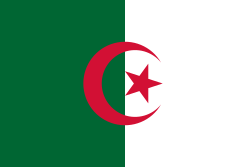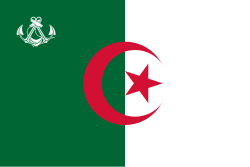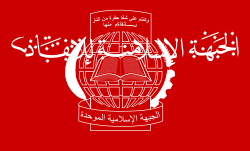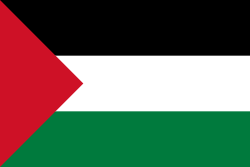This article has multiple issues. Please help improve it or discuss these issues on the talk page . (Learn how and when to remove these messages)
|
The following is a list of flags and banners related with Algeria.
This article has multiple issues. Please help improve it or discuss these issues on the talk page . (Learn how and when to remove these messages)
|
The following is a list of flags and banners related with Algeria.
| Flag | Date | Use | Description |
|---|---|---|---|
 | 1962–present | A vertical bicolor of green and white with the red crescent encircling the red five-pointed star centered along the dividing line. [1] | |
 | National flag (vertical) | ||
| Flag | Date | Use | Description |
|---|---|---|---|
current | |||
 | 1962–present | Presidential flag of Algeria | A vertical bicolor of green and white with the red crescent encircling the red five-pointed star centered along the dividing line with Arabic scripts written in gold upwards and downwards. [2] |
 | |||
former | |||
 | ?–1837 | Flag of Bey of Constantine | |
 | 18th century | Flag of Dey of Algiers | A solid red flag. |
| Flag | Date | Use | Description |
|---|---|---|---|
former | |||
 | 1516–1830 | Land forces Flags (Odjak of Algiers) | |
 | |||
| Flag | Date | Use | Description |
|---|---|---|---|
current | |||
 | 2004–present | Naval ensign of Algeria | |
 | Naval jack of Algeria | The national flag in the canton on a light blue field. [7] | |
former | |||
 | 1987–2004 | Naval ensign of Algeria | A vertical bicolor of green and white with the red crescent encircling the red five-pointed star centered along the dividing line and red crossed fouled anchors in the canton. [6] |
 | A vertical bicolor of green and white with the red crescent encircling the red five-pointed star centered along the dividing line and red crossed fouled anchors in the canton. [8] | ||
 | Rank flag of the Chief of Staff of the Naval Forces | A blue swallowtail flag with a yellow anchor in the center and two red ones in the canton. | |
 | Rank flag of a flag officer of the Naval Forces | A blue swallowtail flag with a white anchor in the center and two red ones in the canton. | |
 | 16th–18th century | Flag of the official in charge of the fleet. | |
 | 16th–early 19th century | Naval flag seen on Algerian ships, including privateers. | |
 | |||
 | 18th–early 19th century | A red flag with a yellow stripe with a red crescent. | |
| Flag | Date | Use | Description |
|---|---|---|---|
former | |||
 | after 1848–1910 | The flag consists of 7 horizontal stripes, 3 white, 2 blue and 2 red. The colors are identical to the French national flag, and the form resembles flags from the Regency times The exact rules and years of use of this flag are unknown. [12] | |
 | 16th–18th century | One of the types of merchant flags of Regency of Algiers | |
 | The flag consists of 5 horizontal stripes, 2 red, 2 yellow and 1 green [10] | ||
 | |||
 | |||
 | Horizontal bisection with white above black. [10] | ||
| Flag | Date | Use | Description |
|---|---|---|---|
 | 1962 | A vertical bicolor of green and white with the red crescent encircling the red five-pointed star centered along the dividing line which is on the hoist side with the French tricolour "in the manner of the Commonwealth countries, Canada or Australia". |
| Flag | Date | Party | Description |
|---|---|---|---|
current | |||
 | 1953–present | The flag consists of the Black Standard with a white text of the Shahada emblazoned across it in calligraphy style writing. | |
 | 1954–present | Similar to flag of Algeria. | |
Former | |||
 | 1989–1992 | Red flag with white logo of the ISF, with the groups name in Arabic (الجبهة الإسلامية للإنقاذ) across it. The writing in the box above the logo is from Surah 'Ali `Imran [3:103] of the Quran. (وكنتم على شفا حفرة من النار فأنقذكم منها). Writing at the bottom of the logo states الجبهة الإسلامية الموحدة (en: United Islamic Front). [14] | |
 | 1947–1966 | ||
 | 1920–1962 | A red flag with a white hammer and sickle and the slogan "Pain, Paix, Liberté" (en: Bread, Peace, Liberty). [15] | |
| Flag | Date | Party | Description |
|---|---|---|---|
 | ? | Alleged personal standard of Emir Abdelkader. | The flag was considered to be the emir's personal banner in the French Army Museum, but it may have been confused with Samori Ture. [16] |
 | 19th century | Erroneous flag of French Algeria | A blue flag with the French tricolor in the canton. Some sources suggest its use in the Algiers Pavilion at the Exposition Universelle in Paris in 1900, but this is not certain. [17] |
 | 17th century | The banner of the Dey of Algiers according to the erroneous description of a 17th century French traveler. | A green flag with a yellow crescent. [18] |